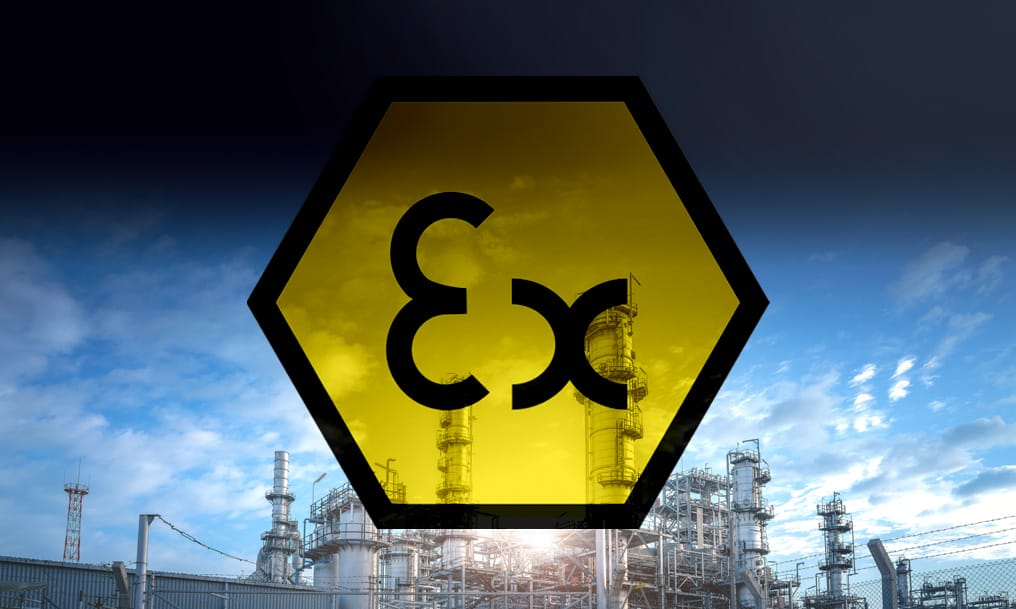Simplifying ATEX Coding
Announcements | Monday, 24th June Share
ATEX coding can be hard to understand. Because of this, we have created the below guide to help simplify how this works.
What is ATEX coding?
ATEX coding is an alphanumeric sequence that indicates a product’s certification, specifying the environments and conditions for which it is suitable. This code consists of a prefix, such as CE0518 Ex II 2 G, and a suffix, such as Ex d IIC T6 Gb. A product may feature multiple suffixes for the same prefix to define its applicability to various environments, such as gas and dust hazards.
What does the ATEX prefix mean?
The ATEX prefix comprises five parts. The first part confirms the product’s compliance with the European Directive (CE) and includes the reference number of the notified body that issued the certification. Next is the ATEX logo, represented by Ex within a hexagon. The third section identifies the Equipment Group, with Group I indicating use in mines where firedamp may be present and Group II for all other environments, with industrial applications typically using Group II. The fourth part specifies the Equipment Category, which includes M1 and M2 for mines and 1, 2, or 3 for other environments. Higher numbers denote lower protection levels, with 1 or M1 offering the highest protection. Some certifications may list multiple Equipment Categories. The fifth part of the prefix indicates the environment type, with G for gases or vapours and D for combustible dusts. Devices with dual certification for both gas and dust environments will have separate suffixes for each hazard.
What does the ATEX suffix mean?
The ATEX suffix details the specific protection method used to prevent the device from causing an explosion in hazardous areas. It always starts with Ex, denoting Explosion Protection, followed by four sections tailored to either gas or dust applications. Devices often have separate suffixes for gas and dust, reflecting certification for both hazards.
Types of protection?
Various methods exist to prevent ignition in hazardous environments, and the Types of Protection indicate the method used. After Ex, one or two letters specify the protection type. Some types require an additional character to denote the protection level and applicable hazardous area Zone or Category. Common protection types for valves and measuring instruments include Ex d (flameproof), Ex e (increased safety), Ex m (encapsulation), Ex n (non-sparking), and Ex ia (intrinsically safe). Types d, e, and m are suitable for Zones 1 or 2, Categories 2 or 3, unless a second character (a, b, or c) imposes further limitations. Protection types can be combined, such as de, em, or me.
Ex d, often misinterpreted as explosion proof, is actually flameproof, containing any internal flames without allowing them to escape into the hazardous atmosphere. Ex e signifies increased safety, ensuring no arcs, sparks, or hot surfaces. Ex m involves encapsulation, preventing the atmosphere from contacting any potentially incendiary parts. Ex n, similar to Ex m, means non-sparking, suitable for Zone 2, Category 3 environments. Ex ia, or intrinsically safe, is suitable for Zone 0 or 20, Category 1, achieved by limiting energy in sparks and surface temperatures to very low power levels.
Gas or dust?
This section identifies the Gas Group or Dust Type for which compliance has been certified. Group I is for mining applications. Group II covers gas hazards and is divided into IIA, IIB, and IIC, indicating different potential gases. Group III pertains to dust hazards, divided into IIIA, IIIB, and IIIC. IIA is for combustible flyings, IIIB for non-conductive dusts, and IIIC for conductive dusts. The C rating within these groups offers the highest safety level, providing the greatest risk protection.
Temperature class?
The Temperature Class rating (T1, T2, T3, T4, T5, or T6) for gases indicates the maximum surface temperature the device can reach, ensuring it stays below the ignition temperature of the gas. Dust hazard classifications use a T followed by the maximum surface temperature in degrees Celsius.
Equipment protection level?
The Equipment Protection Level, similar to the Equipment Category, includes Ma and Mb for mining, and Ga, Gb, Gc for gas, and Da, Db, Dc for dust, with Ga or Da offering the highest protection. Determining if a product is suitable for a specific area involves understanding the site’s risk assessment, which classifies areas into Zones. Zone 0 (gas) or 20 (dust) indicates a continuously present risk, requiring high protection like Ex ia. Zone 1 or 21 (dust) means the risk is likely during normal operations, commonly using Ex d, Ex e, or Ex m. Zone 2 or 22 (dust) suggests a risk during short periods, often using Ex m or Ex n. Higher-rated protections can be used in less hazardous zones if necessary.
If you would like more information regarding this article, please contact us at info@247able.com or +44 (0)118 916 9420.

Share this with
X Facebook LinkedIn Email